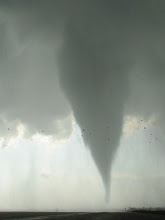I don't have time to get too in-depth with this... actually haven't even looked at as much data as I'd have liked to. I may try to chase after a 5-hour sleep following work this morning, maybe targeting the dryline in southcentral KS. Here are some random thoughts for tomorrow.
-Even if the pseudo-cold core play (occluded/cold front in NE) was within reach, I'm still not sure I see it as being better than the dryline play. I don't see a baroclinic boundary, and while surface winds may be isallobarically backed up there, low-level shear doesn't look any better than points south given a more backed storm motion and the likelihood of a weaker LLJ. Still, wouldn't be surprised to see a few tornadoes up there (especially if they heat up well into the 60s°F)... though my hunch is that convection will assume the form of line segments. One thing that is better about the N target is a very high chance of daytime initiation, though.
-The first thing that concerns me about the dryline target is the extremely strong surface pressure gradient across southcentral and eastern KS... surface winds are no doubt being underforecast by the models, and that could easily be somewhat of an SRH-killer tomorrow afternoon. As I alluded to in previous posts, 30 kt sustained winds are generally "not your friend" on a chase day. The NAM-WRF indicates the pressure gradient and surface winds should begin to relax by 00Z and more certainly by 03Z, which should naturally allow for an increase in low-level shear. My hope is that sr-hodographs as forecast (250-350 m2/s2 of 0-1 km SRH, with rightward deviance not having a whole lot of net effect on the SRH magnitude in this event) are still large enough such that stronger-than-forecast surface winds still allow for fairly large SRH (> 200 m2/s2).
-Another thing that concerns me about the dryline play, particularly given that I work tonight, is the timing of convective initiation. Interestingly, the 00Z NAM-WRF weakens the forward-side-of-trough 5H wind max between 18Z and 00Z as it rotates atop the KS dryline... fragmenting the vorticity into a piece north (closer to the mid-level low center) and a trailing piece back in the dry air. The attendant vertical motion field is similarly fragmented, not organizing over and then intercepting the dryline until after 00Z... and I have to wonder if it is related to the weakening of the mid-level jet. (I've had a good number of chases in the past, some involving a cold core and some not, where I've been left high and dry under the mid-level jet max... while initiation and tornadoes occur farther N, just east and southeast of the primary vort center). High-res simulated radar reflectivity from both the 00Z NMM and ARW don't initiate dryline convection until between 00Z and 03Z, either, and the 00Z and 06Z operational NAM-WRF and 03Z NAM-KF all indicate initiation starting right around 00Z (7 P.M. ... not really worth trying to chase given my working tonight). It's anyone's guess whether this guidance will come to fruition as described, but regardless, it is supported by the background mass fields and overall it lessens my confidence in getting storms to pop earlier rather than later. One would think that with a strongly convergent dryline and lifting/cooling of the residual cap from the west... initiation would be possible by 4-6 P.M. We shall see. We certainly can't have our moisture mixing out if we want to achieve dryline initiation. Which leads me to...
-My last concern, obviously, is the magnitude of moisture. The 00Z NAM-WRF forecast is a bit better than prior runs, indicating surface dewpoints solidly in the upper 50s°F over southcentral KS by peak heating. 100mb ML dewpoints on the 00Z RAOBs were already around 50°F, so we don't have far to go... with the 55°F surface isodrosotherm about near the Red River as I type. I worry about the effects of the strong vertical mixing, though, and whether we will end up with poorer boundary layer moisture than is forecast. It certainly isn't a good sign that boundary layer moisture didn't improve any over deep south TX during the last 24 hours, per the 00Z Brownsville and Corpus Christi RAOBs.
One final thing which will be interesting is the evolution of convection as the plunging cold front overtakes the dryline, which wasn't addressed much in the otherwise excellent 06Z SPC Day 1 Outlook. The large scale pattern bares some resemblances to May 1, 2008... with an extremely intense band of high-level difluence/divergence forecast to overtake the sharpening cold front between 03Z and 12Z. Could this lead to another very damaging QLCS with embedded circulations/F3 tornadoes? Hopefully not, but an organized squall line with some damaging gusts seems like a good bet.
It's also good to see that an extreme snow event is looking less likely for central ND, as the upper low is now forecast to be weaker (with filling low-level cyclones) as it lifts northeast and gradually opens into a shear axis. My family back home is dealing with flooding due to tons of melting snow already, and they really don't need another 18" on top of it. Hopefully they skate by with 6-8" in Bismarck.
Monday, March 23, 2009
Subscribe to:
Post Comments (Atom)

No comments:
Post a Comment